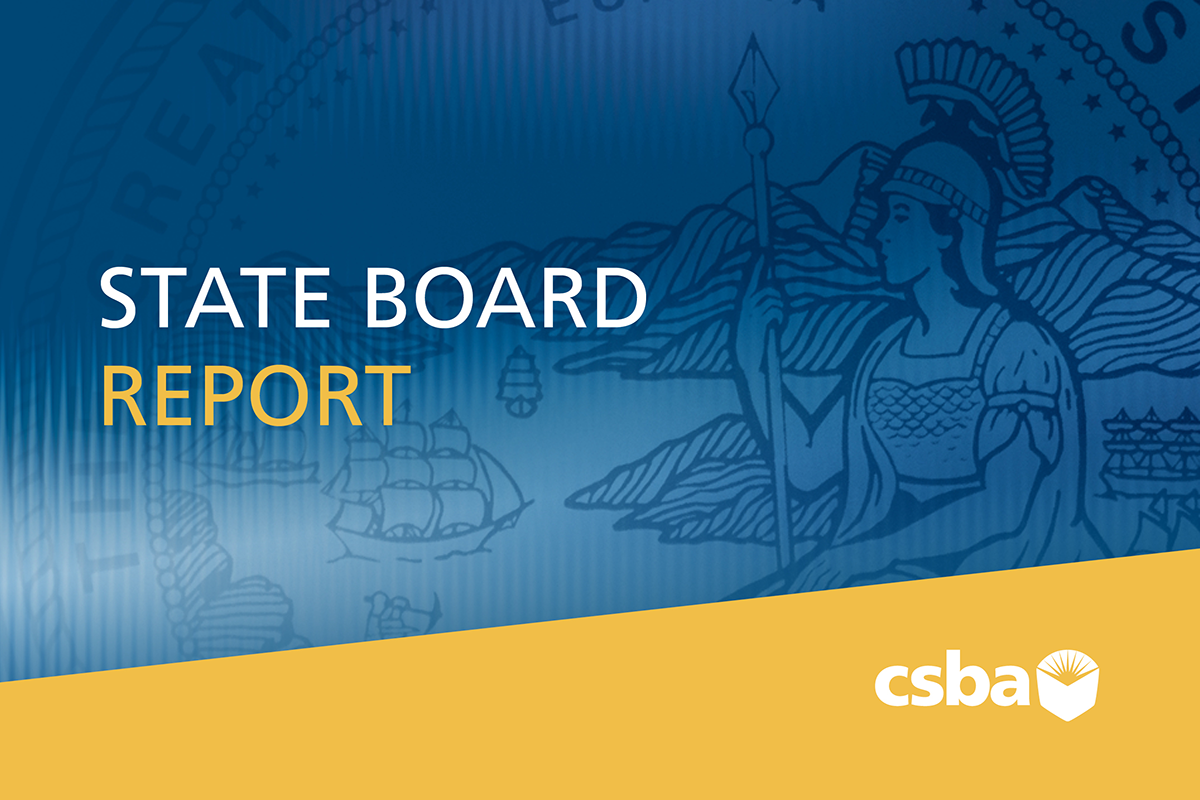A regular annual update to the State Board of Education at its March 11–12 meeting about the California School Dashboard raised serious questions and concerns from board members about several proposals.
While only an information item, the board informed California Department of Education staff that much more clarity and direction must be provided about the proposed inclusion of a student growth model on the 2020 Dashboard. California is one of only two states that does not measure school performance based on the growth of individual students’ scores on standardized tests over time. A push from many organizations and researchers led the CDE to study growth models over the last year, with CSBA participating in a stakeholder work group.
As the CDE moves forward, State Board member Sue Burr said the state must be “crystal clear” with parents and local educational agencies about what, exactly, the growth model data is conveying about students. For example, she said the model may not necessarily provide valid insights into whether students are prepared to do work at grade level when they cross from elementary school to middle school and middle school to high school.
Board member Patricia Rucker shared similar concerns. “I’m not sure we have a clear consensus as a board on what we’re trying to do with the model,” she said. “Because I heard several different points or goals for the purposes, and none of that would be addressed or given to us with a residual gain model.”
Board President Linda Darling-Hammond said the discussion will likely continue at May’s meeting to more closely calibrate expectations. “There are a lot of folks here excited about this growth model, and I don’t want us to disappoint,” board member Ting Sun added. “If we don’t have the initial conversations before CDE goes and does their technical work, I think we’re going to be working against each other.”
Questions also raised over cut scores for ELPI
Board members also raised concerns over the proposed cut scores for “status” in the English Learner Progress Indicator based on the 2020 ELPAC Summative Assessment results. Vice President Ilene Straus, board member Feliza Ortiz-Licon and Rucker said that the methodology used for the indicator — while used for other indicators in the past — cannot be accurately identifying all districts whose English learner students are not performing at the expected level.
“When we have the number of sites or LEAs that were identified, with none or few in LA County, Orange County and Imperial County — which are the highest concentration of English learners — then we should probably revisit our methodology to see if it’s still an appropriate one for this indicator,” Ortiz-Licon said.
Thurmond, Darling-Hammond address coronavirus impacts
State Superintendent of Public Instruction Tony Thurmond updated board members on how the coronavirus (COVID-19) is impacting schools. Thurmond directed county office, district and school leaders to guidance released by the CDE and California Department of Public Health. CSBA has additionally produced a thorough resource with extensive information and guidance that can help boards and school leaders confront the difficult decisions involved with coronavirus.
Thurmond also reported that he participated in a March 9 gathering in Sacramento with many of the state’s 58 county superintendents and Gov. Gavin Newsom. Thurmond said the forum allowed leaders to share local concerns on issues ranging from lost instructional days to the availability of school meals should a school close. “We can’t answer every question they will come up with or every scenario that they might fear or anticipate, but what we’ve done is built a structure of how to work through it together and game plan through those systems together,” he said.
“I know there are a lot of anxious students and parents and I know our school staffs are doing their best to maintain supportive learning environments,” Darling-Hammond said of the evolving situation. “And I thank all of those administrators and teachers who are dealing with the many, many questions and decisions around the virus.”
In other State Board meeting news:
- Reflecting the state’s increased attention to demands for career technical education, the board approved the fiscal year 2019–20 Career Technical Education Incentive Grant allocations, including the allocation formula and specific funding amounts for districts and schools. Deputy Superintendent Khieem Jackson said CTE remains a top issue for students as they desire to have more career pathways at their schools and within their districts. “This issue was really reinforced to me yesterday when I met with between 40 to 50 students from various school districts within Orange County. And of the many things they talked to me about — school funding, mental health — CTE was one of them,” he said.A CDE presentation shows the following LEA breakdown of the $150 million in ongoing funding designated for the CTEIG program:
Small category: <140 ADA (20 LEAs) $2,445.576
Medium category: 141–550 ADA (52 LEAs) $10,108,579
Large category: 551–1100 ADA (264 LEAs) $137,445,845 - The board approved the “Skills Attainment for Upward Mobility; Aligned Services for Shared Prosperity: California’s Workforce Development Plan 2020–2023” under the federal Workforce Innovation and Opportunity Act of 2014. The approval of the plan will allow California to receive about $1 billion in federal funds to supplement state workforce development efforts.
- Also in the area of workforce development and career training, board members approved the submission of the Draft Federal Perkins V State Plan for Career Technical Education to the Governor’s office for review. It will be used to “leverage state-funded CTE programs and support the development of a broader California State Plan for CTE, particularly given that California intends to lead with state programming.”
- In a large update from the assessments division, which included discussion about lackluster performance in the first run of the California Science Test, the board approved the 2019–20 apportionment rates for the California Assessment of Student Performance and Progress and the English Language Proficiency Assessments for California. The CAASPP rates remain the same as last year, while schools will see an increase of 50 cents per pupil to the apportionment rate for the Initial ELPAC in kindergarten and grade one and for the Summative ELPAC in kindergarten through grade two.
- Following a presentation at the January board meeting on the state’s 2018–19 annual performance report for Part B of the Individuals with Disabilities Education Act, the board approved the state’s submission of its State Systemic Improvement Plan to meet federal requirements. Corresponding presentations from Arcadia Unified School District and the El Dorado County Special Education Local Plan Area offered examples of continuing efforts to align supports and services provided to LEAs that benefit students with disabilities to improve outcomes.
- The meeting marked the end of their terms for board members Ortiz-Licon and Nikki Sandoval, leaving two vacancies that Gov. Newsom will fill. Ortiz-Licon took office in April 2015, while Sandoval assumed the role in January 2013.
The next State Board meeting is scheduled for May 6–7 at the CDE headquarters in downtown Sacramento. View the full meeting calendar. The Instructional Quality Commission, the advisory body on curriculum and materials to the State Board, next meets April 17 at the CDE.




